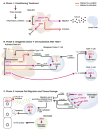The Role of Janus Kinase Signaling in Graft-Versus-Host Disease and Graft Versus Leukemia
- PMID: 29289756
- PMCID: PMC5993569
- DOI: 10.1016/j.bbmt.2017.12.797
The Role of Janus Kinase Signaling in Graft-Versus-Host Disease and Graft Versus Leukemia
Abstract
For patients with hematologic malignancies, allogeneic hematopoietic cell transplantation (alloHCT) offers a potential curative treatment option, primarily due to an allogeneic immune response against recipient tumor cells (ie, graft-versus-leukemia [GVL] activity). However, many recipients of alloHCT develop graft-versus-host disease (GVHD), in which allogeneic immune responses lead to the damage of healthy tissue. GVHD is a leading cause of nonrelapse mortality and a key contributor to morbidity among patients undergoing alloHCT. Therefore, improving alloHCT outcomes will require treatment strategies that prevent or mitigate GVHD without disrupting GVL activity. Janus kinases (JAKs) are intracellular signaling molecules that are well positioned to regulate GVHD. A variety of cytokines that signal through the JAK signaling pathways play a role in regulating the development, proliferation, and activation of several immune cell types important for GVHD pathogenesis, including dendritic cells, macrophages, T cells, B cells, and neutrophils. Importantly, despite JAK regulation of GVHD, preclinical evidence suggests that JAK inhibition preserves GVL activity. Here we provide an overview of potential roles for JAK signaling in the pathogenesis of acute and chronic GVHD as well as effects on GVL activity. We also review preclinical and clinical results with JAK inhibitors in acute and chronic GVHD settings, with added focus on those actively being evaluated in patients with acute and chronic GVHD.
Keywords: Graft-versus-host disease; Hematopoietic cell transplantation; Janus kinase.
Copyright © 2017 The American Society for Blood and Marrow Transplantation. Published by Elsevier Inc. All rights reserved.
Figures

References
-
- Center for International Blood & Marrow Transplant Research (CIBMTR) [Accessed October 6, 2017];HCT trends and survival data. Available at: https://www.cibmtr.org/referencecenter/slidesreports/summaryslides/Pages....
-
- Reddy P, Maeda Y, Liu C, Krijanovski OI, Korngold R, Ferrara JL. A crucial role for antigen-presenting cells and alloantigen expression in graft-versus-leukemia responses. Nat Med. 2005;11:1244–1249. - PubMed
-
- Horowitz MM, Gale RP, Sondel PM, et al. Graft-versus-leukemia reactions after bone marrow transplantation. Blood. 1990;75:555–562. - PubMed
Publication types
MeSH terms
Substances
Grants and funding
LinkOut - more resources
Full Text Sources
Other Literature Sources

